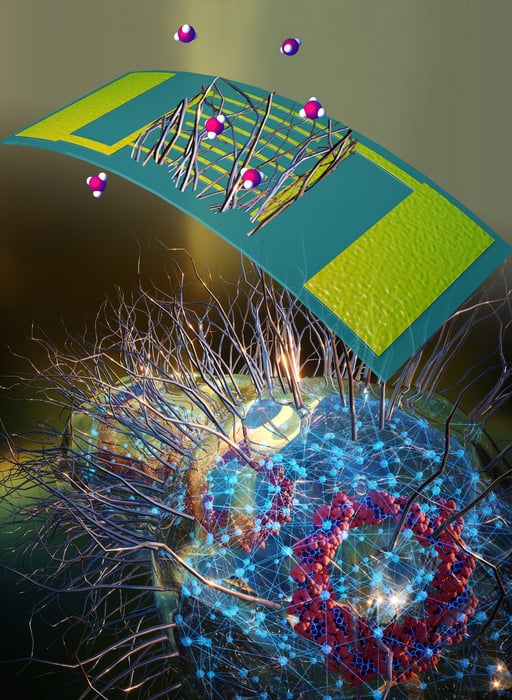
A new nanowire structure that can be grown by a common bacterium could be used as an “electronic nose” to detect a variety of chemical tracers, including those exhaled by patients with medical conditions such as asthma and kidney disease. The device, developed by a team of researchers at the University of Massachusetts Amherst, is more sensitive than conventional inorganic nanowire sensors, while being biodegradable and more sustainably produced.
Nanowires can be used to fabricate highly efficient and versatile sensors by adding different functional groups that bind specific analytes to the nanostructures. The problem is that traditional techniques to do this are complicated. What is more, the wires are often made from highly toxic materials, such as carbon nanotubes or silicon, which need to be processed at high temperatures and involve the vaporization of hazardous components.
A little help from E. Coli
The researchers, led by microbiologist Derek Lovley and electrical engineer Jun Yao, made their nanowires with the help of a bacterium known as Geobacter sulfurreducens, which naturally grows tiny, electrically conducting nanowires thanks to a specific gene known as pilin.
This microorganism needs very specific conditions in which to grow, however, so the researchers extracted this gene and spliced it into the DNA of another bacterium, Escherichia coli, which, in contrast, is extremely easy to culture.
Once the gene was inside the E. Coli, Lovley, Yao and colleagues modified it to include peptide ligands. These are short tails of amino acids exposed on the outer surface of the nanowires that specifically bind chemicals of interest.
Such pilin-based nanowires have already been employed as electronic components in a range of applications, including devices that generate electricity from humidity in the atmosphere, neuromorphic memory devices and sensors. An advantage of these nanostructures is that they can easily be modified by changing the pilin gene sequence. Their conductivity, for example, can be tuned over a wide range, from 40 µS/cm to 277 S/cm, by simply changing the number of aromatic amino acids in the pilin protein.
A high affinity for ammonia
In the new work, which is detailed in Biosensors and Bioelectronics, the researchers studied a peptide called DLESFL, which has a high affinity for ammonia (a chemical often present in the breath of people with kidney disease).
The E. Coli began to grow nanowires as expected and the researchers collected these nanostructures to build them into a sensor. They did this by drop-casting a purified solution of the protein nanowires onto the surface of a pair on electrodes and allowing the solution to dry in air. They connected the sensor to a commercial characterization system and applied a voltage of 1 V across the electrodes. They then measured the sensor’s response to ammonia by monitoring its change in conductivity.
The team found that the genetically-modified protein nanowires were 100 times more sensitive to ammonia than the unmodified ones, while functioning much better than sensors fabricated with conventional silicon or metal nanowires.
Sensing devices akin to the nose
“It is possible to design different ligands for each of a wide variety of chemicals, not just ammonia,” explains Lovley. “Incorporating a diversity of wires capable of detecting different molecules should therefore make it possible to produce sensing devices akin to the nose, which contains hundreds of sensors each sensitive to a specific molecule.”
Since they are made from common bacteria, the new nanowires are far more sustainable than conventional nanowires, adds Yao. “Our line of research takes electrical engineering in a fundamentally new direction,” he says. “Instead of nanowires made from scare raw resources that won’t biodegrade, the beauty of these nanowires is that you can use life’s genetic design to build a stable, versatile, low impact and cost-effective platform.”
According to the Amherst team, application areas include biomedical monitoring of chemicals in breath or in sweat on the skin to sense metabolites indicative of disease. Environmental sensing in water for pollutants and plant nutrients is also a possibility.
“Our study is a proof-of-concept investigation demonstrating that it is possible to genetically tune the protein nanowires to sense specific chemicals with high specificity,” Lovley tells Physics World. “We now plan to design nanowires to sense a wider range of chemicals, and structure the electronics into a commercially viable configuration.”


